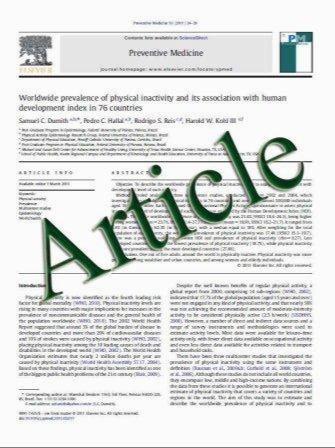Relationship Between Obesity and Diabetes in a US Adult Population: Findings from the National Health and Nutrition Examination Survey, 1999–2006
- نوع فایل : کتاب
- زبان : انگلیسی
- مؤلف : Ninh T. Nguyen & Xuan-Mai T. Nguyen & John Lane & Ping Wang
- چاپ و سال / کشور: 2010
Description
Background Obesity is one of the most important modifiable risk factors for the prevention of type 2 diabetes. The aim of this study was to examine the prevalence of diabetes with increasing severity of obesity and the distribution of HbA1c levels in diabetics participating in the latest National Health and Nutrition Examination Survey (NHANES). Methods Data from a representative sample of adults with diabetes participating in the NHANES between 1999 and 2006 were reviewed. The prevalence of diabetes and levels of fasting glucose, insulin, c-peptide, and HbA1c were examined across different weight classes with normal weight, overweight, and obesity classes 1, 2, and 3 were defined as body mass index (BMI) of <25.0, 25.0–29.9, 30.0–34.9, 35.0–39.9, and equal to 40.0, respectively. The distribution of HbA1c levels among adults with diabetes was also examined. Results There were 2,894 adults with diabetes (13.6%) among the 21,205 surveyed participants. Among the adults with diabetes, the mean age was 59 years, the mean fasting glucose was 155±2 mg/dl, and the mean HbA1c was 7.2%; 80.3% of diabetics were considered overweight (BMI≥25) and 49.1% of diabetics were considered obese (BMI≥30). The prevalence of adults with diabetes increased with increasing weight classes, from 8% for normal weight individuals to 43% for individuals with obesity class 3; the distribution of HbA1c levels were considered as good (<7.0%) in 60%, fair (7.0–8.0%) in 17%, and poor (>8.0%) in 23%. The mean fasting glucose and HbA1c levels were highest for diabetics with BMI <25.0, suggesting a state of higher severity of disease. Mean insulin and c-peptide levels were highest for diabetics with BMI=35.0, suggesting a state of insulin resistance. Conclusions In a nationally representative sample of US adults, the prevalence of diabetes increases with increasing weight classes. Nearly one fourth of adults with diabetes have poor glycemic control and nearly half of adult diabetics are considered obese suggesting that weight loss is an important intervention in an effort to reduce the impact of diabetes on the health care system.
OBES SURG (2011) 21:351–355 DOI 10.1007/s11695-010-0335-4 Published online: 3 December 2010


